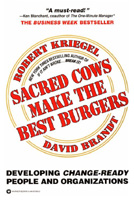
The title of the book intrigued me "Sacred Cows Make the Best Burgers". Being a Hindu by religion and Indian by Nationality, I have endured a number of inquisitive queries around Sacred cows (Do they really wander around the highways in all cities? Are they the main reason behind the traffic snarls in cities?).
A quick drive to the library and 5 days later I was pleasantly surprised by the thoughts discussed in the book. The clever use of title was the tip of the iceberg for an authoritative book on how organization need to handle change. In over 18 years of my consulting experience, I personally have seen or observed some of the situations in the book and I now personally believe that these concepts can be applies not only to organizations but to individuals also.
Sacred Cows Make the Best Burgers : Developing Change-Ready People and Organizations
Robert Kriegel with David Brandt
The overall concept addressed in the book is simple. Every organization has its own set of sacred cows - Process, Systems, People- who are considered too sacred to question or challenge. They go about on their own misguided agenda creating chaos and waste as did the cows in some of the smaller towns in India. Nobody wanted to move the cows and organization do not want to disturb the status quo. The authors advocate a process for identifying these Sacred cows in organization and some tips on how best they can be removed to improve the efficiency and effectiveness of the organization.
People are the the gatekeepers of change. They resist change because it is uncomfortable unpredictable and hence unsafe. To avoid getting out of their comfort zone, they slowly become the sacred cows themselves or the guardians of other Sacred Cows. The authors suggest a 5 step process to help organizations deal with this issue - Starting with Rounding up the Sacred Cows, Developing a change ready environment, Turning resistance to readiness, Motivating People to change and finally developing seven personal change ready traits.
There are a number of Sacred Cows the authors have found dwelling in these organizations. Here are my favorite ones.
The Paper Cow : Remember the multiple copies of forms we fill for no obvious reasons?
The Meeting Cows : Long recurring meetings which no one remembers the objective or the agenda?
Speed Cow: The superstar in the office who does things so fast that you get dizzy watching him and angry when you later fix the errors he has created ? The authors introduce an interesting phrase : A passionate 90% effort is more effective than a panicked 110%. This is so true in some of the organizations where I see lot of things get done but without any though quality or value
Expert Cow: This one is on the top of my list. The "guru" who has answers to all questions even those which have not yet been asked? The authors have an answer to this - Be Smart, Ask stupid questions.
Techno Cow: This applies to me to a T few years back. Enjoying technology for the coolness factor and forgetting that the solution is not a means to stoke my ego but to meet the needs of a business user. The authors take - High Tech needs high touch !
Team Cow: The premise in some organizations that to get things done , throw a group of people in a room and keep your fingers crossed that they will come up with a solution.
Once you have identified these cows wandering in the corridors of the organization, it requires a hunting season where employees are asked to hunt and replace these cows.
For building a change ready environment you cannot plant seeds on a hard ground
Buy from Amazon
 RSS Feed
RSS Feed
